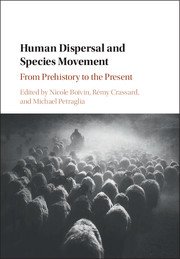Book contents
- Frontmatter
- Contents
- List of text boxes
- List of figures
- List of tables
- List of contributors
- Preface
- I Introduction
- II Origins: Species Movements in the Pleistocene
- III Across the water: Species movements by Coast and Sea
- 6 Coastlines, marine ecology, and maritime dispersals in human history
- 7 Breaking down barriers: Prehistoric species dispersals across Island Southeast Asia, New Guinea and Australia
- 8 The last great migration: Human colonization of the Remote Pacific Islands
- IV Complexity: Species Movements in the Holocene
- V Invasion: The Movement of Invasive and Disease Species
- Index
- Plate section
- References
8 - The last great migration: Human colonization of the Remote Pacific Islands
from III - Across the water: Species movements by Coast and Sea
Published online by Cambridge University Press: 04 May 2017
- Frontmatter
- Contents
- List of text boxes
- List of figures
- List of tables
- List of contributors
- Preface
- I Introduction
- II Origins: Species Movements in the Pleistocene
- III Across the water: Species movements by Coast and Sea
- 6 Coastlines, marine ecology, and maritime dispersals in human history
- 7 Breaking down barriers: Prehistoric species dispersals across Island Southeast Asia, New Guinea and Australia
- 8 The last great migration: Human colonization of the Remote Pacific Islands
- IV Complexity: Species Movements in the Holocene
- V Invasion: The Movement of Invasive and Disease Species
- Index
- Plate section
- References
Summary
Abstract
In this chapter we outline the last major human migrations with the discovery and settlement of the Pacific Islands. The last phase of this expansion resulted in colonization of the eastern Pacific with more than 500 remote islands ranging from tropical, subtropical, temperate, and sub-Antarctic, varying in size and landforms, and comprising just 289,000 km2 of land over more than 20 million km2 of ocean. Reanalysis of radiocarbon dates for the region shows that migrations into the most remote Pacific occurred just over 1000–800 years ago, proceeded more rapidly than previously held, and included dispersal of plants and animals that invaded and disrupted unique and fragile island biotas. Human impacts profoundly transformed pristine ecosystems with habitat loss, the impacts of invasive rats, dogs, and pigs, as well as human predation. Successful human colonization led to natural environments transformed into agriculturally productive systems.
Keywords: Migrations, colonization, radiocarbon, human impacts, eastern Polynesia
The handle of my steering paddle thrills to action,
My paddle named Kautu-ki-te-rangi.
It guides to the horizon but dimly discerned.
To the horizon that lifts before us,
To the horizon that ever recedes,
To the horizon that ever draws near,
To the horizon that causes doubt,
To the horizon that instills dread,
The horizon with unknown power,
The horizon not hitherto pierced.
The lowering skies above,
The raging seas below,
Oppose the untraced path,
Our ships must go.
– Polynesian deep-sea chant, Sir Peter Buck (Te Rangi Hiroa)INTRODUCTION
The last major human migrations over the planet occurred with the discovery and settlement of the remote islands of southern and eastern Polynesia. This remarkable episode included colonization of more than 500 remote tropical, subtropical, temperate, and sub-Antarctic islands comprising just 289,000 km 2 of land scattered over more than 20 million km 2 of ocean. Settlement of these islands with concomitant dispersal of plants and animals disrupted unique island biotas that evolved in relative isolation. Human colonists profoundly transformed pristine ecosystems with vegetation change and introduced cultigens, weeds, and animals, as well as a wave of extinctions associated with habitat loss, predation, and the impacts of invasive rats, dogs, and pigs. Natural environments were transformed into agriculturally productive systems, raising island carrying capacities for humans.
- Type
- Chapter
- Information
- Human Dispersal and Species MovementFrom Prehistory to the Present, pp. 194 - 216Publisher: Cambridge University PressPrint publication year: 2017
References
- 5
- Cited by



